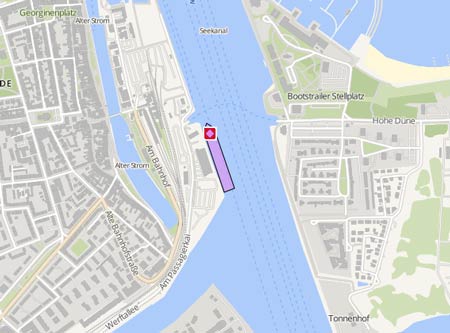YUEDA2
Kurs/Position
Die letzten Häfen
Die letzten Wegpunkte
Die neuesten Nachrichten
Unfamiliarity with route led to Amakusa Island grounding
Unfamiliarity with the route to an anchorage outside of Prince Rupert led to the grounding the Amakusa Island last year. That was the finding of the Transportation Safety Board, which on Monday released its investigation report on the July 14 ship grounding. The charterer of the ship directed the master to anchor to address cargo issues prior to sailing to Japan and the Prince Rupert Port Authority directed the ship to anchorage 25. However, neither the ship's master or the pilot on board was familiar with the route to that anchorage, a route that went near a charted shoal that was too shallow for the vessel to pass. The shoal was not detected by the bridge team while planning the route or monitoring the move and pilot's portable pilotage unit was not configured with all of the route planning and monitoring features to aid in detecting hazards. As a result of the grounding, the Canadian Hydrographic Service has updated the chart used on the route. As well, the BC Coast Pilots Ltd reached an agreement with the Pacific Pilotage Authority to require pilots to undergo mandatory assessments at least every five years and provide improved programs to monitor pilots' familiarity with the areas they serve. The Amakusa Island managers have installed an electronic chart display and information system on board the vessel and have initiated additional crew training. The 228-metre bulk carrier ran aground on July 14 while shifting from berth at Ridley Terminals to its assigned anchorage. The vessel, which has 80,000 metric tonnes of coal in its hold, suffered damage to its hull and began taking on water. To prevent more from entering, the Amakusa Island's water-tight bulkheads were closed. http://www.thenorthernview.com/news/327733781.html
Fate of bulker Amakusa Island that ran aground in Prince Rupert yet to be determined
The fate of the Amakusa Island, which ran aground on Monday night and is heavily listing in Prince Rupert's outer harbour, has yet to be determined. Prince Rupert Port Authority manager of corporate communications Michael Gurney said the ship, which is loaded with 80,000 metric tonnes of coal, suffered damage to the hull that caused the vessel to take on water. "We're not sure how much water was taken on, but the damage to the hull caused two buoyancy compartments to be compromised so the water-tight bulkheads closed to prevent water from entering the rest of the ship," he said. "Members of the Transportation Safety Board flew in yesterday to investigate and evaluate the ship and divers have been dispatched to determine the extent of the damage to the hull. Based on that data ... whether repairs or evacuation of water will take place in situ or at one of the berths has to be decided." While there is no timeline in place for repair, Gurney said the ship "will not be travelling from Prince Rupert in its current state". The Amakusa Island was shifting position from berth at Ridley Terminals to its assigned anchorage shortly after 10 p.m. on July 12 when it became grounded. The Canadian Coast Guard and Prince Rupert Port Authority Security Operations Centre, along with other port partners, responded and the vessel was freed by SMIT Marine tugs at approximately 2:30 a.m. It then proceeded to anchorage under its own power, escorted by tugs and a port authority harbour patrol boat. Although the ship visibly listed while aground, there were no injuries or environmental contamination reported or observed. However, the Prince Rupert Port Authority continues to monitor the situation and the Transportation Safety Board has deployed a team of investigators to the site of the grounding. Source and Photo report on http://www.thenorthernview.com/news/267190351.html
Prince Rupert ship grounding highlights risk of oil spill, critics warn
The grounding of a bulk carrier ship near Prince Rupert this week highlights the grave risk of an oil spill if tanker traffic is allowed to increase dramatically on the North Coast, environmentalists and First Nations warn. The 228-metre Amakusa Island ran aground Monday night in Prince Rupert’s outer harbour while it moved to an assigned anchorage from a berth at the Ridley Terminals coal terminal. The incident ripped a gash in the ship’s hull and caused the flooding of two ballast tanks. Although the cause of the grounding is still under investigation, Coastal First Nations executive director Art Sterritt pointed out that weather conditions at the time were “very, very, very, very good.” Human error, on the other hand, is unpredictable. “Mistakes happen, and no matter what kind of technology you have or how good your pilots are or anything else — all the stuff that Northern Gateway has been throwing at us — at the end of the day, people are fallible and accidents happen,” Sterritt said. One defence Enbridge has used to counter safety concerns about tankers carrying oil from the proposed Northern Gateway pipeline is that those ships would be guided by local pilots familiar with the curves of the coast. However, a licensed B.C. pilot was on board the Amakusa Island at the time it grounded. Although B.C.’s pilots are “some of the finest mariners on the coast,” they can’t be expected to prevent every accident, said Brian Falconer, marine operations coordinator for Raincoast Conservation Society. Read more: http://www.vancouversun.com/news/Prince+Rupert+ship+grounding+highlights+risk+spill+critics+warn/10036049/story.html#ixzz37hw6Unnm
News schreiben

